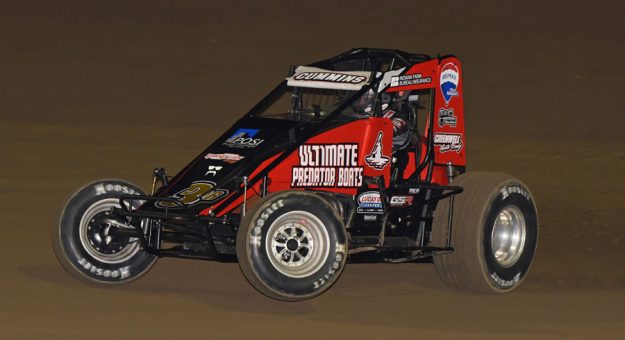INDIANAPOLIS — Few things in this American racing life are as timeless as a multi-night sprint car meet.
There are historic examples on both coasts: in Pennsylvania, the National Open at Williams Grove, and in California, the Oval Track Nationals at Perris Auto Speedway. The heartland has Iowa’s Knoxville Nationals, Eldora’s Kings Royal in Ohio and, for 11 years now, USAC’s three-nights-in-August Smackdown at Indiana’s Kokomo Speedway.
Kokomo is a fast, slightly asymmetrical, swollen quarter-mile, just perfect for non-winged action.
Its USAC races pull in that group’s travelers and the best weekend warriors in the region. None of the Smackdown’s previous winners — Bryan Clauson, Dave Darland, Kevin Thomas Jr., Tyler Courtney and Justin Grant — fluked his way into victory lane.
Across its two preliminary nights and its 40-lap Saturday finale, the cream always rises to the top.
It may be a young event compared to, say, the Gold Cup at California’s Silver Dollar Speedway — run this year for the 68th time — but the Smackdown is a race with a soul. The camping areas are loaded with modest RVs, luxury motorhomes and a few tents. In the parking lot, the tailgating starts early, and the T-shirt trailers do a brisk business.
It feels the way a big race should.
I walked the pits in the sunshine on Thursday and Friday, watching the contenders give their equipment a final once-over. Sprint cars are basic, stripped-down machines, but that doesn’t mean they’re simple; a Rubik’s cube doesn’t look too complicated, either, until it’s your turn to hold one.
That explained the frowns and the tight smiles on the faces of those making adjustments.
I stood there thinking about all the USAC legends, drivers and mechanics and owners alike, who’d been through similar pre-race drills. Reach back to any sprint car era, and there they are: Pancho Carter and Steve Stapp; Gary Bettenhausen and Willie Davis; Sheldon Kinser and Jack Steck; Johnny Rutherford and Wally Meskowski; A.J. Foyt and A.J. Watson.
If your memory can’t see them, your imagination — fueled by all you’ve read and all you’ve heard — can conjure them as clearly as if you were standing there in 1960, ’74 or ’82. Like I said: timeless.
Timeless and, for those of us lifers hooked on the romance of racing, oddly beautiful.
Some of the men fiddling with their Smackdown entries have already elbowed their way into the record books.
The rest may follow, in time. Scattered in the nooks and crannies of the Kokomo pit area, toiling just the same as those old-timers did, were Grant and Dylan Cook; Thomas Jr. and Alec Sipes; Kyle Cummins and Tim Spindler; Brady Bacon and D.J. Lebow; C.J. Leary and Bill Michael; Mitchel Moles and Andy Reinbold.
Some of their work produced magic. Grant won Thursday’s feature, but fast-timer Cummins, forced to start last by a flat tire during the pace laps, was electrifying; he charged all the way to second, and given another lap he might have stolen Grant’s trophy. His pace owed a lot, obviously, to his afternoon collaboration with Spindler.
It was the same for Friday night’s winners, Thomas and Sipes. And the rookie Moles, from a cutely named farming burg called Raisin City, in California’s fertile San Joaquin Valley, showed off his own raw speed and that of the Reinbold car, setting third-quick times on Thursday and Friday.
When Saturday’s Smackdown finale was over, there was Cummins, hoisting the ubiquitous oversized winner’s check, which told an incomplete story. The check said that he’d earned the first-place prize of $15,000, which was true enough. But in leading all of 40 laps, each of which paid a bonus of $500 to the man out front, he boosted that total by $20,000.
That $35,000, said Cummins, made this “by far the biggest win” of his career.
His dominant ride, the red Hank Byram No. 3, sat behind him, crackling and moaning softly as it bled off engine heat, exhaust heat, brake heat and tire-pressure buildup. It looked and sounded like a sprint car trying to catch its breath.
But if you stared a bit longer, you saw more than red; there were also flashes of blue, green, orange, yellow, and white, the other colors of a perfectly executed Rubik’s cube.
Think back again on the USAC legends of yesteryear: Don Branson and Jud Phillips; Parnelli Jones and Joe Pittman; Roger McCluskey and Rocky Philipp; Bobby Unser and Don Shepherd; Bubby Jones and Jim McQueen. On this weekend, Kyle Cummins and Tim Spindler were as good as any of them.
The general rule of these multi-night gatherings is that once one of them is over — whether you raced a car, worked on one or simply watched — you wake up the next morning relieved that it’s over.
For some, it’s a physical and mental surrender after three nights of work and worry. For others, the body needs a break from wrestling a bucking four-wheel bronco that wouldn’t stop trying to jump the cushion. Let’s face it, for some fans and racers, the relief comes from realizing they finally can sleep in and nurse that hangover.
After all, most of these big shows take place in the summer months and the beer flows more casually on warm evenings.
But the older I get, the more I find myself feeling differently. I end up wishing the program had one more night left to run, half for the thrill of the racing and half for the joy of wandering through the pits, saying hello to friends old and new, and looking on as the best minds in the game try to coax more speed out of their sprint cars.
I can’t see myself ever growing tired of that.
